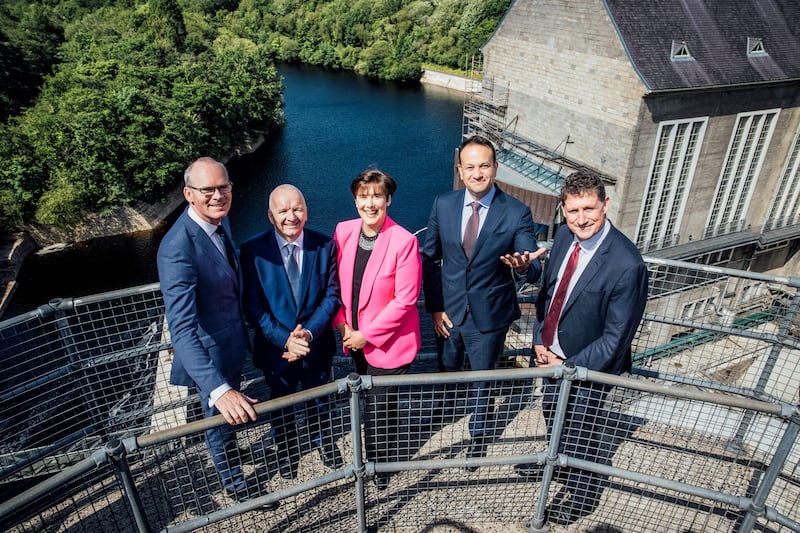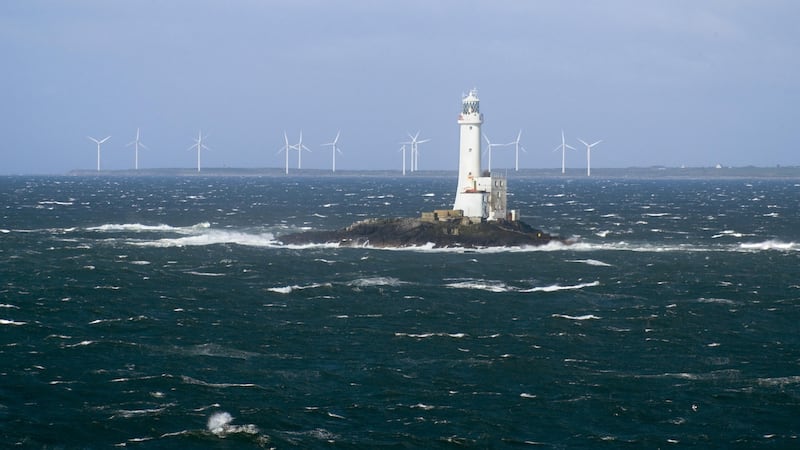The Government is making a fundamental policy error in not backing near term development of floating offshore wind farms, according to Shannon Estuary Economic Taskforce (SEETF) chairman Barry O’Sullivan.
A decision to effectively hold off on supporting use of floating technology until the 2030s by Minister for Energy Eamon Ryan and his Department of Environment, Climate and Communications not only misses out on immense opportunity but threatens future foreign direct investment “and is going to put our existing economic base at risk”, warns the former IDA board member.
This coincides with many European countries scaling up floating offshore and port development and “continued concern for the existing Irish industrial base due to a lack of affordable clean power in this increasing digital age”.
The taskforce was commissioned by the Government to assess future development of the Shannon estuary while exploiting renewables off the west coast.
READ MORE
Stakeholders including offshore developers worked within the department and the Department of Enterprise and Employment officials producing the report on “how to harvest Atlantic wind by 2032″. It recommends investment in the estuary’s two deepwater ports.
It calls for a Designated Maritime Area Plan (DMAP) for the west to flag where floating wind farms could be located; the creation of a “national floating offshore wind development agency” (a one-stop-shop to oversee delivery), and IDA Ireland funding to establish nearby ECO energy hubs.
At its launch last July, then-taoiseach Leo Varadkar said the plan was visionary and acknowledged the region’s potential as a leader in “building new industries, producing green fertiliser, producing sustainable aviation fuels, powering the nation and also creating power for exports”.

Meanwhile, Ryan said: “The estuary has the capacity to rebalance the national economy and be an answer to climate change.”
O’Sullivan, whose background is in manufacturing at multinational level, notably with Johnson & Johnson, adds: “We did our launch in July. Everybody was happy ... I thought our job was done.”
Engagement with senior department officials had been intense and detailed though some bumps did surface. In February 2023 when the department was working on fixed offshore, a “plan-led”, rather than developer-led, approach was announced but there was no plan as such on “who’s go to do what, where to get the power ashore”.
O’Sullivan says: “At the end of a three-and-a-half-hour meeting, I said, we’ll do the plan for you. Would you be open to us sitting down with the developers and coming back to yourselves? They said ‘absolutely’. I was amazed but I realised they didn’t have resources.”
In April, they participated in a consultation on the second Offshore Renewable Energy Development Plan. “The process for the west coast was a mess. The map was in the wrong place, and it was too small, and the water was too shallow. The turbines would be too visible from the shore. They agreed they hadn’t covered themselves in glory there [but] committed to finalising a DMAP by September 2024,” O’Sullivan says.
When the taskforce started working with floating offshore developers – the ESB; Simply Blue, Mainstream and DP Energy were involved with SSE joining later – he was struck by their despondency though they “desperately wanted to wear the Irish jersey”. Coming from “FDI land”, he was conscious of how success comes from site leaders wanting to grow their businesses.
[ New south coast wind farms to be concentrated initially off Waterford and WexfordOpens in new window ]
“These people weren’t gonna take on anything because they felt let down, left right and centre ... they did not trust DECC [Department of Environment, Climate and Communications]. It took a long time to get them on board,” he says.
In September, O’Sullivan received a phone call from a developer saying it was all off. The Department of the Environment, Climate and Communication were not going to do the Designated Maritime Area Plan. They went back to the department to be told “we will consider starting to look at the DMAP in the middle of 2027″.
“We were told floating offshore wind is too expensive and it’s too risky,” he says.
The department had met Ørsted CEO Mads Nipper and others who said “not to bother with that until at least 2035 and to focus on fixed offshore wind”.
They sourced reports indicating by 2035 floating offshore wind in the North Sea will be the equivalent price of fixed offshore wind based on 10 metres per second (m/s) wind speed. “We have 14m/s average wind speeds in the Atlantic, and as power is proportional to the cube of wind speed, 14 is 2.7 times better than 10.”
There’s is no clear line of sight as to how they’re going to be delivered, and every country in Europe right now with a coastline and deep water is going after floating offshore wind
— Barry O' Sullivan
This coincided with him learning the ESB was involved in two floating offshore wind projects in Scotland. O’Sullivan notes the contradiction of the department not supporting floating because of risk, while the State-owned ESB was undertaking probably €1.5 billion to €2 billion of risk to the benefit of the Scottish economy.
SEETF pushed the case for the Designated Maritime Area Plan anyway as it knew of data centre operators who wanted to come to the Shannon estuary for the green power.
O’Sullivan discovered the most experienced and qualified people to do Designated Maritime Area Plans in the public system were in Clare County Council. “They were mad to do it. They were going to do a DMAP for the foreshore in the estuary anyway. This [option] was greeted with a point-blank no.”
They were asked by department officials to approach the council to see if they were prepared to second people to the department. He agreed to do this if they would be ring-fenced to work on the west Designated Maritime Area Plan. The answer was “no”.
“Then it dawned on me that the Minister and the department see this as ‘an either or’ ... if we are going to work on floating offshore, we’re going to limit progress on fixed offshore on the south coast.”
He went to then minister for enterprise Simon Coveney, “the taskforce sponsor”, with the message that the opportunity “needs to be demand-led, by industries we can attract, the indigenous companies that can be created, and not be dealt with as an adjunct on to a climate action department”.
“In fairness to him, he got it,” O’Sullivan says. “His department were writing an industrial strategy for offshore wind anyway.
O’Sullivan met Minister for Finance Michael McGrath who said floating offshore was too expensive and too risky. He responded by highlighting the ESB investment and underlined “how dependent we are today on FDI in terms of jobs, in terms of revenue for the Government, that right now we have a climate action plan where targets are legally binding.
“There’s is no clear line of sight as to how they’re going to be delivered, and every country in Europe right now with a coastline and deep water is going after floating offshore wind.”
The technology is ready, O’Sullivan says. The UK has a pipeline of 100GW of potential floating wind projects. Scotland has approved a commercial-scale floating wind farm. France has announced a €4.1 billion support scheme for a Mediterranean project and is scaling up its Atlantic ports. South Korea is to have a 1.5GW floating wind farm operational by 2028.
A massive 16.5GW project in the Celtic Sea is to come ashore in Bristol and south Wales, feeding an economic corridor stretching from London. “What is that going to mean for Irish FDI and industrial policy? We have nothing.”
All this underlines “there’s a huge economic upside opportunity but there’s a downside risk if we don’t move and the cost of being in the game is minuscule”.
“We’re very worried and fearful that Ireland is not just going to is going to miss a huge upside opportunity but it’s also going to put the existing economic base at risk.”
This relates not just to electricity but also natural gas and energy for heat including biomethane.
“We are operating in a periphery region of Europe at well below the average infrastructure with electricity cost of 35 per cent above the European average, and a shortage of power. It’s not a sustainable economic model. And we are sitting on the biggest source of energy that Europe has ... We don’t see a conflict between decarbonisation and a prosperous economy if we are smart about how we approach it,” he says.
In regional terms, the plan’s significance is about “Ireland beyond the M50″ with Eurostat data indicating infrastructure in Dublin is 115 per cent of the EU average, with the south at 50 per cent and the northwest at 36 per cent. The midwest is a microcosm of current difficulties, he says.
“We’re dependent on food and agriculture. We’re dependent on tourism. We’re dependent on FDI and some indigenous Irish companies. But all of them are internationally traded in one form or another. They’re mostly commodities, and they’re price-sensitive.

“Everything is micromanaged in the centre in a world where the pace of change is only getting faster and faster. Let’s do our policies centrally and nationally, so we’re efficient. But let’s get into local implementation because we will not be able to move fast enough otherwise.
“We’re not precious about our plan. It can be another plan. It needs to be credible and the industry needs to be involved in putting it together, so they can go back to their parent companies and boards and international investors because we need their technology and we need their money,” O’Sullivan adds.
Last week, Ryan unveiled the draft Future Framework for Offshore Renewable Energy and a proposed Designed Maritime Area Plan for the south coast. He said floating technology was not viable or economic at this point and rejected claims he was frustrating development of the floating offshore wind industry.
“I would love more than anyone else ... to see floating offshore wind deployable today, because that’s really in truth our big opportunity,” he added. “But I’m sorry, I have had to inform some of our colleagues in Government, as I did in Cabinet ... it’s not commercial. It’s not technically available or viable today.”
[ Four south coast sites expected for offshore wind developmentOpens in new window ]
O’Sullivan, however, cites the stakeholder view that “20GW cannot be met from fixed offshore wind technology alone, given the limited shallow water areas, environmental considerations, other maritime use needs, and visual factors. The proportion from fixed may ultimately become less than half the target, so it would be prudent to allow a contingency of additional floating wind capacity to achieve the necessary 20GW by 2040.”
SEETF, which is currently in limbo, was “deeply disappointed” by the Minister’s remarks when it’s unclear how Ireland will deliver the 20GW target by 2040 without floating wind technology. “Therefore, his lack of support and ambition is a considerable setback to Irish economic and industrial policy for the decade to come.”
Referring to Taoiseach Simon Harris’s promise of “a new energy” for this tenure, he says: “Let us hope now this Government will show the vision and leadership of the first government of this State who built Ardnacrusha, the world’s largest hydroelectric plant in its day, a century ago. 2040 is tomorrow. Today, the risk is beyond minuscule for a government spending €110 billion this year, but the rewards over the next century will be orders greater.”
A DECC spokesman said a cross-Government offshore wind delivery taskforce established by Minister Ryan to ensure a joint approach across Government, agencies and industry was co-ordinating activities required to maximise economic benefits of offshore wind development to the State.
It is involved in identifying all aspects of work on the critical path to delivery of offshore wind and identifying risks and managing associated mitigation measures, he added. Key actions for 2024, “include measures relating to DMAPs and marine planning, biodiversity, grid connection, supply chain, ports policy, skills and workforce, and regulatory consenting”.
The Government recognises that to achieve these ambitions all offshore renewable energy (ORE) technologies will play a vital role, including floating wind, he said. “Floating wind does not yet exist at commercial scale. Of the 13,000 offshore turbines globally, only about 30 are floating. Further, while fixed wind requires little to no consumer support, the premiums paid to date to deploy floating wind would add billions of euro to consumer bills per year, for up to 20 years.
“It is therefore prioritised that more mature fixed technology is maximised in the short-term, while simultaneously preparing for floating wind technology costs to come down to an acceptable level,” the spokesman said.
Actions to this effect, namely developing the spatial planning, route to market and supply chain support are included in the twin policy documents of DECC’s Future Framework Policy Statement and DETE’s Powering Prosperity – Ireland’s Offshore Wind Industrial Strategy, he noted. “The very first action of the Future Framework calls for a roadmap for future ORE development and targets for innovative technologies such as floating wind. The Future Framework also sets out actions to accelerate a West Coast Designated Maritime Area Plan and to investigate Ireland’s floating wind potential at scale.”
Responsibility for Ireland’s marine planning system will soon be transferring from the Department of Housing to DECC. “This will formalise a decision taken by Government last December and has its roots in recommendations made by the former Attorney General in 2022. These recommendations will add significant resources to ensure delivery on the ambition of the Future Framework,” he said.
Spain, Portugal and Norway, “which is regarded as world leader in this field primarily because of their 40-year legacy of an off-shore oil and gas industry, have deferred their floating off-shore programmes because the technology is not viable yet”, he said.
- Sign up for push alerts and have the best news, analysis and comment delivered directly to your phone
- Find The Irish Times on WhatsApp and stay up to date




















